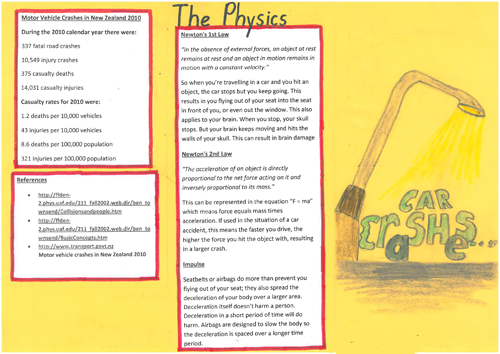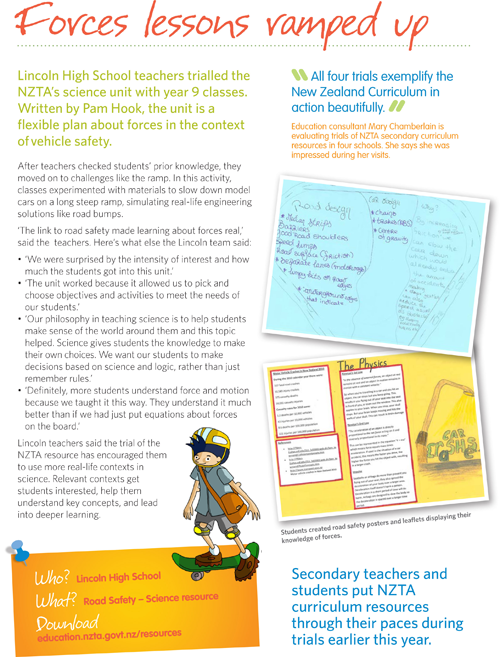Year 10 students undertake a statistical enquiry cycle which gets them discussing safe speeds.
Arts students design and produce posters with their own safety messages aimed at the iPod generation.
Secondary students explore the journeys they make as passengers and write persuasively about the need for safe decisions.
Students get hands-on when learning about forces in the context of safe road travel.
Science: The forces involved in safe stopping
Students get hands-on when learning about forces in the context of safe road travel.
Interviewees: Pam Hook, consultant writer, and Georgina Barrett, Natalie Dwyer, Katie Legg, Jill Crossland and Richard Kent, teacher trialers at Lincoln High School.
The driving question for our unit was: How do we use forces to make crashes survivable?
We started by brainstorming year 9 students’ ideas about forces, then looked at what was relevant and irrelevant to this topic.
We don’t just accept the first thing students say. We ask questions to promote deeper thinking; we say things like, “And that is a good definition because…?”
The students came up with speed, mass, road design, and personal responsibility as the most relevant ideas. It was clear that after that first discussion some students already had a good understanding of forces and were ready to apply it.
Select this link if you can’t view or read this image.
We engaged in a number of activities. We walked around the school and photographed forces at work. For some students, that was the activity where the light went on and they got it. For others it was an activity where they had to construct a long, steep ramp. Their first challenge was to make cars go as fast as they could down their ramp. The second challenge was to make them go as safely as they could and keep their car on the ramp for as long as possible with little Plasticine people on board.
The students used all kinds of materials like sandpaper and bubble-wrap to slow the cars’ speed and make the journey safer. They made the link straight away with speed bumps on roads. When we were talking about slowing things down, we linked it to road construction. The students also came up ideas about corners, tyre tread, types of tar seal, and so on. The link to road safety made learning about forces real.
We were surprised by the intensity of interest and how much the students got into this unit. But then, country students are in cars everyday – wherever they go they have to be in a vehicle – more so than urban students. The unit worked because it allowed us to pick and choose objectives and activities to meet the needs of our students. You need to be able to go through and think, “That would work; that wouldn’t work”, with your own class.
The boys were really interested in a video about the fastest cars in the world drag racing against each other. Some students compared and contrasted two racing cars, one with a drag chute and one without, then looked at the things that were the same and different.
Our philosophy in teaching science is to help students make sense of the world around them, and this topic helped students do that. Science gives students the knowledge to make their own choices. They learn that rules are there for an actual reason – not just because someone says them. We want our students to make decisions based on science and logic – not just to remember rules.
There are definitely more students that understand force and motion because we taught it this way. They understand it much better than they would have if we had just put equations about forces on the board.
The students were interested in trialling something for NZTA. They suggested, in future units it would be good to include some observation of rules in action – for example, the speed different vehicles travel past our school. They said that would enable them to put ideas to the council about how to make travel near the school safer. They were also interested in looking at the physics behind airbags and seatbelts.
Traditionally, teachers are so driven by the things we must teach because they’re in the curriculum. This has opened up our minds about how we can introduce other contexts, not just do things as stand-alone units. It’s important to engage students and to get them to understand concepts behind things. Using contexts that students are interested in is a great way to get engagement that leads to deep learning. We are going to move more in this direction over the next one to two years.
 NZTA Education Portal News - Issue 9 (PDF, 1 MB)
NZTA Education Portal News - Issue 9 (PDF, 1 MB)


